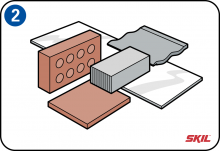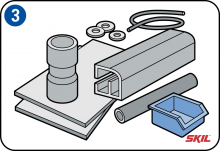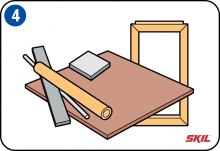-
Wood
Commonly used types of wood include deal, pine, oak, meranti and mahogany. Products made from these wood sorts include plywood and triplex, particle board and MDF, furniture panels, veneer, hardboard, laminate and softboard. All these wood-based materials are easy to work with and join. ‘Normal’ wood can be divided into hardwood and softwood. If you’re drilling in hardwood it’s a good idea to predrill the hole, to avoid unnecessary wear of the drill and breaking of screws.
A tree can be sawed in 5 ways:
1) Beam sawing
2) Double beam sawing
3) Offset beam sawing
4) Through & through sawing
5) Quarter sawing -
Stone and ceramics
Stone and ceramics can be subdivided as follows:
• Structural stone such as bricks, drainpipes, roofing tiles, wall tiles and chimney pipes
• Porcelain such as in kitchenware, floor tiles and wall tiles
• Fireproof materials for high temperatures such as firebricks, glass, cement and ceramics
• Glass such as that used for spectacles (eyeglasses), plate glass, windows, packaging glass, bottles, pressed and blown glass, kitchenware, glass-fiber, insulation and optical fiber
• Natural stones such as diamond, as well as synthetic abrasives for grinding, cutting, polishing or blasting of materials
• Cement and concrete for roads, bridges, buildings and dams -
Plastics
• Plastics shaped by molding or casting
• Polyethylene and nylon
• Elastomers or rubbers which can be shaped elastically. Their main characteristic is that they tend to return to their original shape after they have been subjected to force or heating -
Metals
Commonly used metals for building and construction work are:
• Iron, steel and steel alloys such as cast iron; these are often used for building purposes and in other situations requiring high strength
• Aluminium; is often used because it is easy to shape, light, low-cost and can be recycled
• Copper and copper alloys; these are good conductors of electricity and heat, are tough and have good resistance to corrosion
• Titanium; is used for applications requiring high strength, resistance to high temperatures and high resistance to corrosion
• Nickel; has good resistance to corrosion and is ideal for use at very high temperatures




